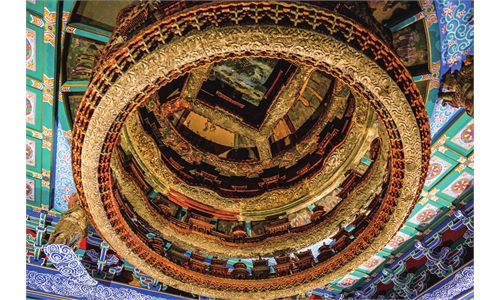ARTS / CULTURE & LEISURE
New Museum dedicated to 4,000-year Taosi site
Findings shed light on early Chinese civilization
Editor's Note:
Ancient artifacts, silent carriers of the country's memories and national spirit, can offer valuable insights into the appreciation of Chinese culture.
In 2023, over 1.29 billion visits were made to museums across the country. Beyond the top national-level museums, smaller museums also offer insights into cities, businesses or groups of people.
The Global Times cultural desk is proud to announce the launch of a series called "Museum Wonders" designed to showcase how these cultural gems illustrate the essence of Chinese civilization and promote its great wisdom.
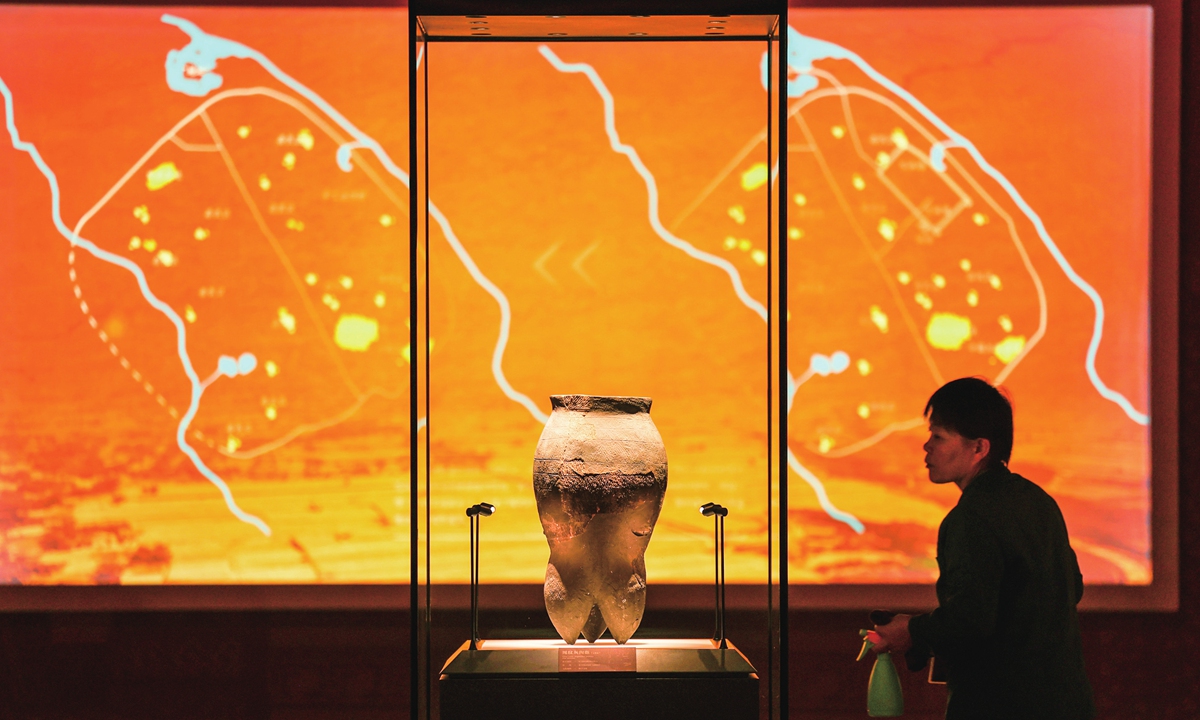
The highly anticipated Taosi Site Museum in Linfen, North China's Shanxi Province, officially opened on Tuesday, offering some answers to these questions.
The museum, located on the loess plateau in Xiangfen county, is dedicated to the archaeological discoveries from the Taosi site, which is a large settlement site from the late Neolithic period, believed to be most likely the ruins of the capital city during the period of Yao and Shun - two sage emperors dating back more than 4,100 years.
The new archaeological discoveries and research advancements of the Taosi site have provided fresh material for the exploration of ancient history, serving as compelling evidence and a vivid portrayal of the unique characteristics of Chinese civilization - diversity in unity, inclusiveness, and continuity, Li Qun, director of the National Cultural Heritage Administration, said at the museum's launch ceremony.
"The opening of the Taosi Site Museum will offer panoramic displays of the significant achievements of Taosi culture in urban planning, handicraft production, and artistic creation," Li noted.
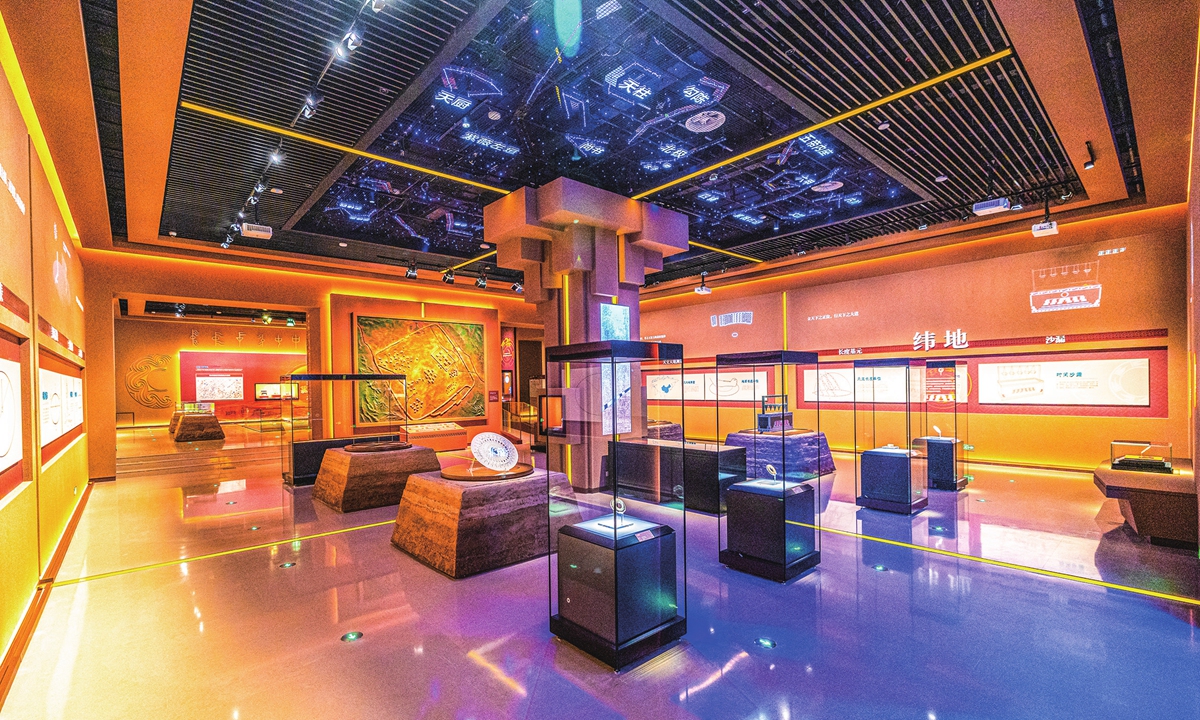
The museum, built on the northwestern edge of the Taosi ruins, spans an area of about 5,000 square meters and houses over 230 important cultural relics, including pottery, jade, stone, and copper artifacts, which show the culture and life of the local ancient inhabitants.
The museum also exhibits relics that some scholars speculate may be related to astronomical observation and time-keeping. For example, one of the standout pieces is the guichi, a measuring tool used in ancient astronomy and calendar systems. The artifact, uncovered at the Taosi site, is the earliest known physical example of such a tool.
Written characters older than oracle bones are also on display. A red-painted pottery vessel unearthed at the Taosi site features two characters, one of which is widely recognized as "wen," closely related to the character for "wen" in the Shang Dynasty (c.1600BC-1046BC) oracle bones and bronze inscriptions. The other character has been interpreted as "yi," "yang," or "yao," offering significant insights into the origins of Chinese writing.
Painted pottery plates, each featuring intricate depictions of a dragon motif, are also one of the highlights of the exhibit. The depicted dragon is a combination of various mythical creatures, proving that as early as the Taosi society, the dragon was revered as a totem, providing important clues about the role of the dragon as a totemic symbol in ancient Chinese culture.
A set of bronze bells, the oldest known examples of their kind, and the discoveries of other instruments, indicate that the system of rites and music was already in its early stages.
"These findings illustrate a new important phase in Chinese civilization's formation and development," said Yan Yalin, director of the National Cultural Heritage Administration archaeology department. Experts noted that Taosi reflects the early characteristics of a state society, foreshadowing later dynastic structures, according to the Xinhua News Agency.
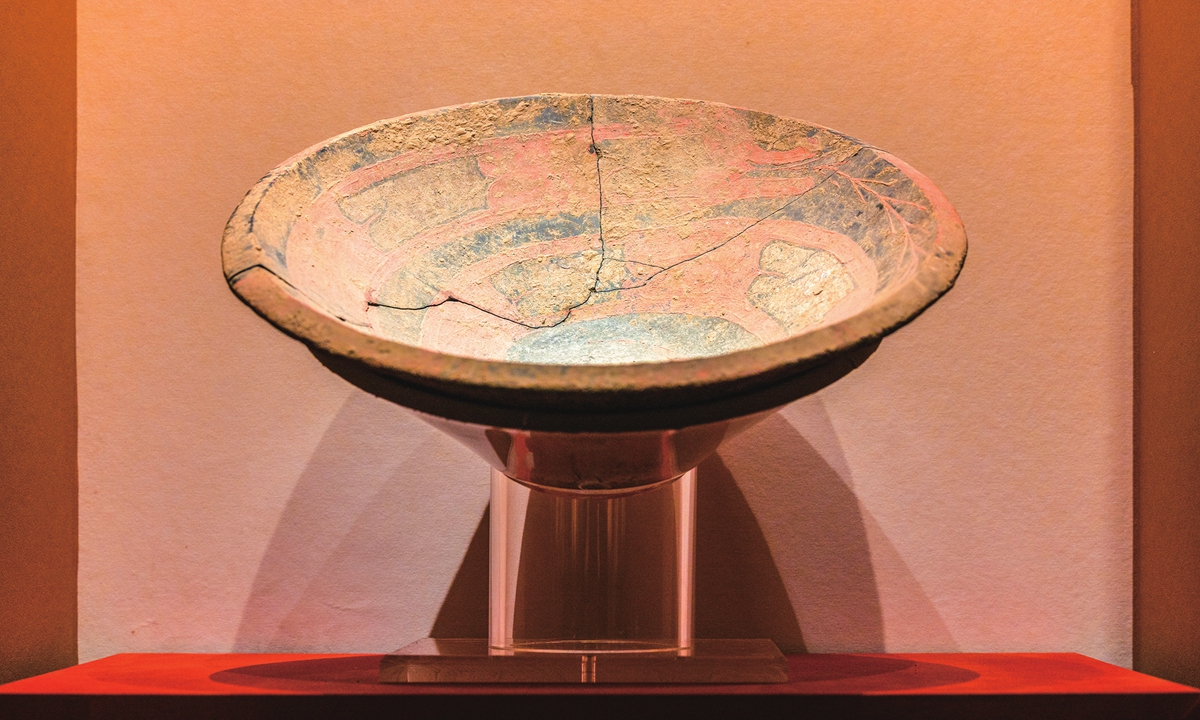
The Taosi site, discovered in 1958 and officially excavated in 1978, covers an area of 2.8 million square meters. Here, only about 30,000 square meters have been excavated so far. Archaeologists have spent over 40 years uncovering unprecedented urban sites, majestic palaces, large cemeteries, and ancient observatories.
Over 1,300 tombs have been excavated at the site, uncovering more than 5,500 artifacts that reveal the early stages of Chinese civilization. This reflects how the Central Plains region, represented by the Taosi site, absorbed various elements of civilization, advanced rapidly, and led a new era of Chinese civilization over 4,000 years ago, local official Wang Yanfeng said at a press conference on November 6.
"Yao and Shun might be mythical, but the era they are associated with is certainly not," Gao Jiangtao, a research fellow at the Institute of Archaeology, Chinese Academy of Social Sciences, told the Global Times.
"A large number of archaeological discoveries show that Taosi was a political, economic, military, and religious center over 4,000 years ago, a typical representative of a national capital," Gao said, adding that future archaeological teams will focus on analyzing the ethnic groups behind Taosi culture, hoping to unveil further the mysteries between the period of Yao and Shun.
Inside the exhibition hall, a diorama replicates the palace, storage, cemetery, sacrificial, handicraft, and residential districts. This illustrates how the Taosi site had a dense population, orderly planning, and a clear division of labor.
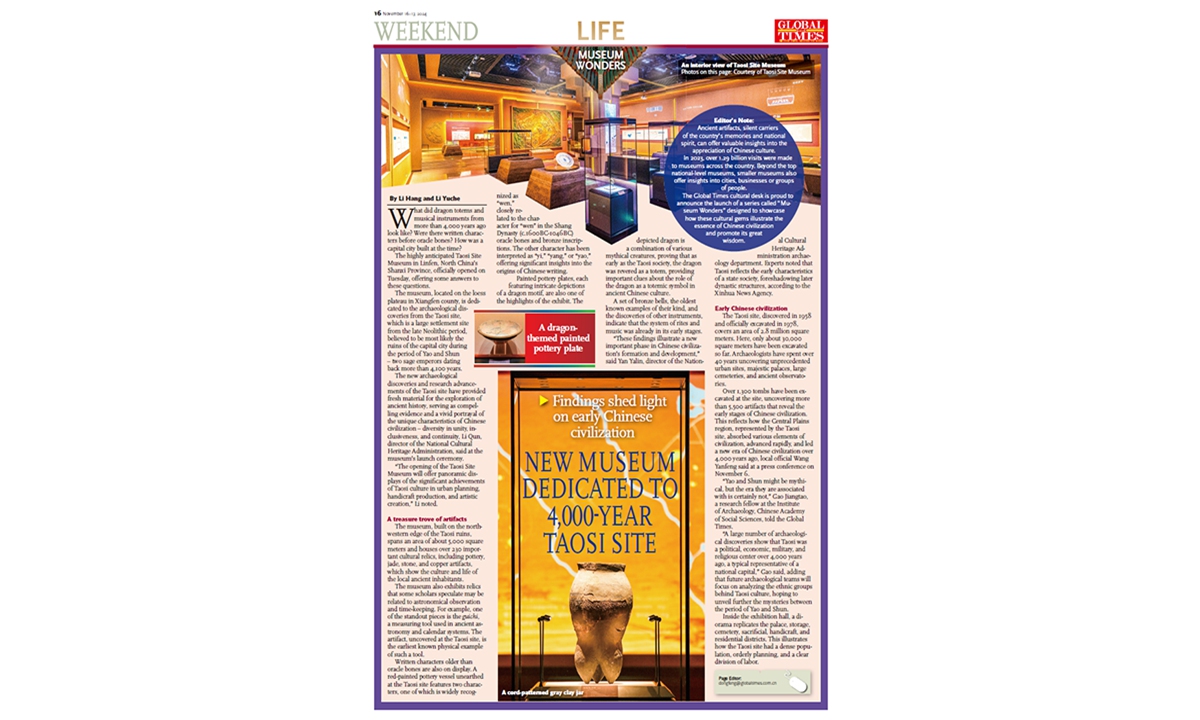
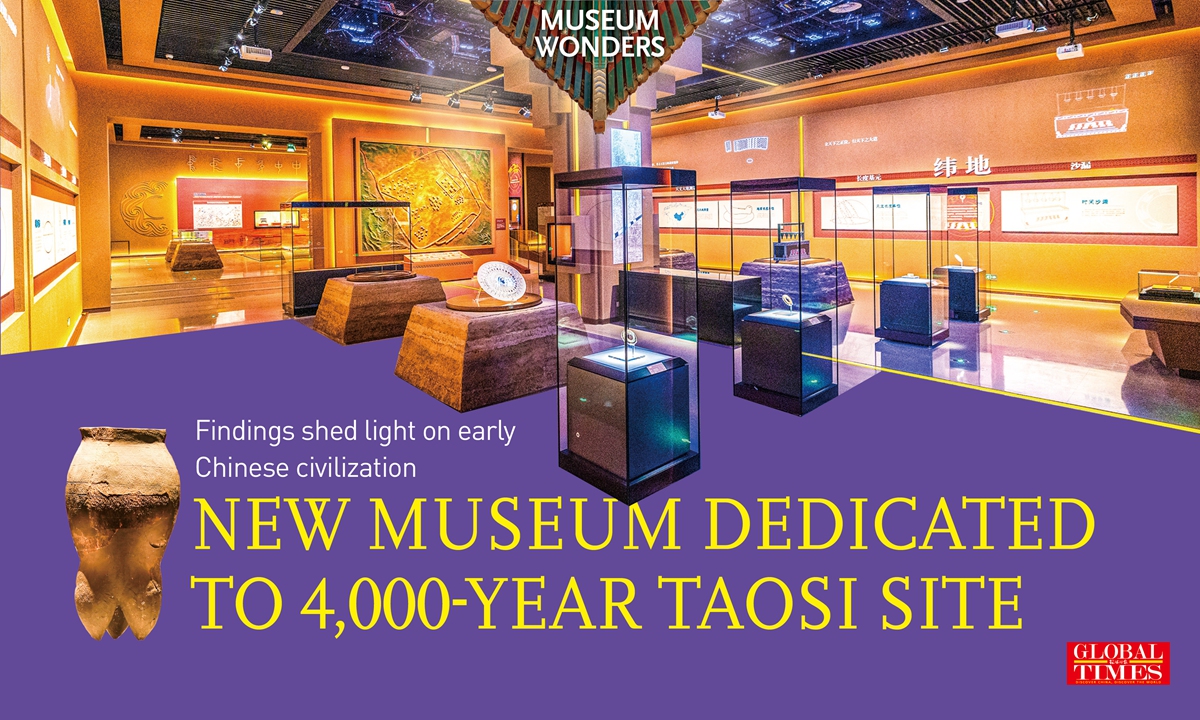
Ancient artifacts, silent carriers of the country's memories and national spirit, can offer valuable insights into the appreciation of Chinese culture.
In 2023, over 1.29 billion visits were made to museums across the country. Beyond the top national-level museums, smaller museums also offer insights into cities, businesses or groups of people.
The Global Times cultural desk is proud to announce the launch of a series called "Museum Wonders" designed to showcase how these cultural gems illustrate the essence of Chinese civilization and promote its great wisdom.

A cord-patterned gray clay jar Photos: Courtesy of Taosi Site Museum
What did dragon totems and musical instruments from more than 4,000 years ago look like? Were there written characters before oracle bones? How was a capital city built at the time?The highly anticipated Taosi Site Museum in Linfen, North China's Shanxi Province, officially opened on Tuesday, offering some answers to these questions.
The museum, located on the loess plateau in Xiangfen county, is dedicated to the archaeological discoveries from the Taosi site, which is a large settlement site from the late Neolithic period, believed to be most likely the ruins of the capital city during the period of Yao and Shun - two sage emperors dating back more than 4,100 years.
The new archaeological discoveries and research advancements of the Taosi site have provided fresh material for the exploration of ancient history, serving as compelling evidence and a vivid portrayal of the unique characteristics of Chinese civilization - diversity in unity, inclusiveness, and continuity, Li Qun, director of the National Cultural Heritage Administration, said at the museum's launch ceremony.
"The opening of the Taosi Site Museum will offer panoramic displays of the significant achievements of Taosi culture in urban planning, handicraft production, and artistic creation," Li noted.

An interior view of Taosi Site Museum
A treasure trove of artifactsThe museum, built on the northwestern edge of the Taosi ruins, spans an area of about 5,000 square meters and houses over 230 important cultural relics, including pottery, jade, stone, and copper artifacts, which show the culture and life of the local ancient inhabitants.
The museum also exhibits relics that some scholars speculate may be related to astronomical observation and time-keeping. For example, one of the standout pieces is the guichi, a measuring tool used in ancient astronomy and calendar systems. The artifact, uncovered at the Taosi site, is the earliest known physical example of such a tool.
Written characters older than oracle bones are also on display. A red-painted pottery vessel unearthed at the Taosi site features two characters, one of which is widely recognized as "wen," closely related to the character for "wen" in the Shang Dynasty (c.1600BC-1046BC) oracle bones and bronze inscriptions. The other character has been interpreted as "yi," "yang," or "yao," offering significant insights into the origins of Chinese writing.
Painted pottery plates, each featuring intricate depictions of a dragon motif, are also one of the highlights of the exhibit. The depicted dragon is a combination of various mythical creatures, proving that as early as the Taosi society, the dragon was revered as a totem, providing important clues about the role of the dragon as a totemic symbol in ancient Chinese culture.
A set of bronze bells, the oldest known examples of their kind, and the discoveries of other instruments, indicate that the system of rites and music was already in its early stages.
"These findings illustrate a new important phase in Chinese civilization's formation and development," said Yan Yalin, director of the National Cultural Heritage Administration archaeology department. Experts noted that Taosi reflects the early characteristics of a state society, foreshadowing later dynastic structures, according to the Xinhua News Agency.

A dragon-themed painted pottery plate
Early Chinese civilizationThe Taosi site, discovered in 1958 and officially excavated in 1978, covers an area of 2.8 million square meters. Here, only about 30,000 square meters have been excavated so far. Archaeologists have spent over 40 years uncovering unprecedented urban sites, majestic palaces, large cemeteries, and ancient observatories.
Over 1,300 tombs have been excavated at the site, uncovering more than 5,500 artifacts that reveal the early stages of Chinese civilization. This reflects how the Central Plains region, represented by the Taosi site, absorbed various elements of civilization, advanced rapidly, and led a new era of Chinese civilization over 4,000 years ago, local official Wang Yanfeng said at a press conference on November 6.
"Yao and Shun might be mythical, but the era they are associated with is certainly not," Gao Jiangtao, a research fellow at the Institute of Archaeology, Chinese Academy of Social Sciences, told the Global Times.
"A large number of archaeological discoveries show that Taosi was a political, economic, military, and religious center over 4,000 years ago, a typical representative of a national capital," Gao said, adding that future archaeological teams will focus on analyzing the ethnic groups behind Taosi culture, hoping to unveil further the mysteries between the period of Yao and Shun.
Inside the exhibition hall, a diorama replicates the palace, storage, cemetery, sacrificial, handicraft, and residential districts. This illustrates how the Taosi site had a dense population, orderly planning, and a clear division of labor.


